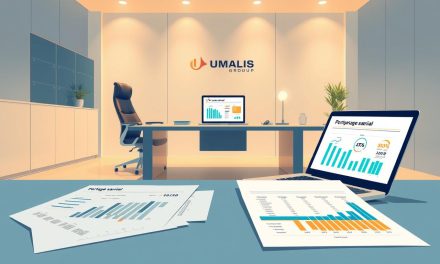We know the freelance life in France can feel unpredictable. Imagine Claire, a freelance designer in Lyon, who swapped long client lists for clearer goals. In a year she focused on one niche, improved her rates, and landed steadier projects.
This story shows a simple truth: progress is not only promotions or raises. For independent professionals, it means more control, varied responsibilities, and work that fits values and energy.
In 2025 the market favors specialists who show measurable outcomes, proven processes, and ongoing development. This guide will map a practical way to track growth, pick the right opportunities, and build a repeatable system without corporate layers.
Table of Contents
Key Takeaways
- Progression is broader than a ladder—focus on impact, rates, and fit.
- Specialize and show results to match current market trends.
- Use simple systems to measure growth and show your value.
- Prioritize skill development and steady, small improvements.
- Leverage peer feedback and networks for support and confidence.
What career progression means when you’re an independent professional
Advancing as a solo practitioner is about shaping your process to deliver more value. We define this as improving the way you work—the methods, systems, and habits that make results repeatable. That is the « how » that powers your long-term ambitions.
Growth answers the question of where you want to go: a higher-value market, a new service mix, or a clearer career path. Progress is the set of deliberate steps that take you there.
- Examples beyond promotion: expanding project scope, moving into advisory roles, raising average rates, or winning larger clients.
- Responsibility shifts: from task execution to owning outcomes and leading client communication.
- Measure impact: documented case studies, repeatable frameworks, and clear client metric lifts.
Start by auditing your current roles and services to spot where your contribution already shines and where processes can be tightened. For practical steps and tools, see our professional growth guide.
Why career development matters for freelancers in 2025
Planned professional growth gives freelancers a clear edge in 2025’s fast-moving market. Clients now expect proof of impact and efficient delivery. Showing measurable results wins trust and better briefs.
Benefits: satisfaction, new opportunities, faster goals, and stability
- Higher satisfaction: Aligning work with strengths reduces burnout and raises motivation.
- More opportunities: A visible track record attracts better-fit clients and larger briefs.
- Faster goal attainment: A structured plan helps you focus on high-leverage actions and save time.
- Income stability: Transparent pricing and value articulation support retainers even without a traditional salary.
Leading tech firms tie advancement to impact and measurable outcomes. That trend benefits independent professionals who document performance and repeatable methods.
We recommend a short checklist to shape your year: prioritize client outcomes, speed, specialization, and partnerships that compound reach. Small weekly investments in skill growth compound into real stability and clearer opportunities.
Start with clarity: assess your current role and set SMART career goals
Begin with a clear snapshot of what you offer and who benefits most from your work. List services, ideal clients, average deal size, win rate, and how pricing matches perceived value.
Evaluate services, clients, pricing, and market fit
Structure the audit into simple processes: what you deliver best, which packages win, and where margin slips. Scan public job descriptions and tenders to spot in-demand skills.
Turn ambitions into SMART goals and OKR-style targets
Translate aims into measurable goals with quarterly key results. Assign ownership (you), timelines, and metrics so each target is testable and repeatable.
Close gaps with focused learning and feedback
Use lightweight learning—courses, shadowing calls, and small pilots—to build portfolio proof. Collect short client retrospectives and peer reviews for actionable feedback.
| Audit item | Simple metric | Action |
|---|---|---|
| Services | Win rate (%) | Refine top 2 offers |
| Clients | Average deal size | Target ideal profiles |
| Pricing | Margin per project | Adjust packaging |
| Skills | Market demand | Plan focused learning |
Design your freelance career ladder and framework

Build a simple, competency-led ladder that maps how your work expands from hands-on delivery to broader market influence.
Start by defining four clear levels for your solo practice: Individual Delivery, Client Outcomes Lead, Portfolio Lead, and Ecosystem Contributor.
Use company frameworks as a mirror — translate Dropbox’s pillars (Results, Direction, Talent, Culture) into client-facing expectations and craft standards for your expertise.
Create dual tracks and impact steps
Adapt Buffer and Wise: a Maker track focused on deep craft, and a Manager track focused on client leadership and light subcontracting.
Follow Spotify’s logic: measure growth from individual delivery, to leading client teams, to shaping multi-client standards, and finally to wider ecosystem influence.
Map milestones and a practical example
At the « Client Outcomes Lead » role you co-define OKRs with a client, run weekly checkpoints, and deliver post-mortems. This demonstrates repeatable impact and makes progression objective.
- What to track: responsibility scope, communication style, leadership signals, and business outcomes.
- Pricing hint: set a salary-equivalent reference per level to align packages with market expectations.
| Level | Key responsibilities | Communication & leadership | Pricing reference |
|---|---|---|---|
| Individual Delivery | Execute tasks, meet specs | Clear briefs, weekly updates | Project-rate / hourly |
| Client Outcomes Lead | Define OKRs, co-own results | Stakeholder facilitation, rituals | Retainer / value fee |
| Portfolio Lead | Scale frameworks across clients | Templates, mentoring partners | Tiered packages |
| Ecosystem Contributor | Shape standards, publish IP | Thought leadership, collaborations | Premium retainers / licensing |
Keep the framework light: a one-page matrix and a quarterly review will help you track levels, compare against company ladders, and plan the next step on your path.
For tools and a short guide on ongoing development, see our career development resource.
Build new skills with focused professional development
Focus your learning on a small set of high-impact skills that directly improve what clients pay for. Pick one technical ability tied to measurable client outcomes and one soft skill that makes delivery smoother.
Prioritize technical and soft skills: training, courses, and continuous learning
Choose training and courses that are practitioner-led and outcome-focused. Short, project-based courses (like industry micro-credentials) work better than long theory-only programs.
Make a simple learning plan: a targeted course, a 30–60 day practice project, and a deliverable that proves new skills. Reserve 10–15% of your capacity for this work so delivery stays steady.
Seek challenges to stretch: new industries, projects, and interdisciplinary skills
Accept stretch assignments—spec pilots, advisory mini-engagements, or cross-discipline collaborations—to turn knowledge into confident practice. Use these projects to test courses and training before wider adoption.
- We recommend: one technical skill, one soft skill, a time-boxed application, and a short case note.
- Why it works: professional development multiplies leverage per hour, improves scoping, and sharpens decision-making under ambiguity.
Track new skills against your ladder and publish a brief case note after each cycle. For more practical steps, see our career progression guide.
Grow opportunities: networking, visibility, and client communication

A focused visibility plan — events, outreach, and clear client rituals — turns connections into repeatable opportunities.
Professional network tactics: events, outreach, and strategic collaborations
Build a simple rhythm: one event a month, weekly outreach to targeted people, and a quarterly collaboration that compounds reach.
- Networking cadence: follow our networking cadence to make contacts reliable and measurable.
- Craft first messages that add value — a micro-audit, a short insight, or a relevant resource.
- Partner with complementary experts to win larger project outcomes and diversify deal flow.
Show accountability and initiative with clients to unlock bigger roles
Propose agendas, capture risks early, and send concise summaries after each meeting. These small acts signal ownership.
Suggest one process improvement or a short pilot to demonstrate leadership. This often expands your scope without heavy negotiation.
Improve communication processes to strengthen performance and referrals
Install lightweight rituals: weekly status notes, clear change requests, and end-of-sprint reviews. They reduce misunderstandings and lift performance.
Make people look good: praise collaborators publicly and share clear outcomes. That builds a referral engine and long-term development opportunities.
Your career progression operating system: tracking, feedback, and reviews
Treat your professional life like a lightweight operating system: log events, review outcomes, and iterate fast. This makes your work visible and gives you control over choices you make over time.
Keep an achievement log: outcomes, feedback, rates, and portfolio proof
Keep concise records of wins: before/after metrics, client quotes, rate changes, and training completed.
Use short notes so you can reuse evidence in proposals, case studies, and applications.
Schedule regular reviews with mentors or peers; iterate your development plan
Set a simple cadence: weekly check-ins for momentum, monthly retros to adjust the plan, and quarterly reviews with a mentor or peer circle.
- Track a minimal scoreboard: pipeline health, close rate, average deal size, on-time delivery, and client satisfaction.
- Collect feedback with short forms and brief debrief calls. Tie responses to decisions so insights are actionable.
- Keep « learning development » notes: what worked, what failed, and the next experiment.
Link each achievement to your ladder criteria so each win signals the next level. For measurable metrics and a compact set of indicators, see our performance metrics guide.
Result: a calm, repeatable rhythm that protects your time and clarifies goals for clients, employees, and potential companies you work with.
Conclusion
Finish with a simple, evidence-led plan that turns learning into repeatable client value.
Choose one clear goal, one skill to practice, and one short project to test it. This small routine makes growth tangible and easy to share with clients and peers.
Keep a light ladder of roles and measurable steps. Use brief case notes from courses and pilots to prove your impact and open new opportunities.
Protect time and energy: set boundaries so ambition stays sustainable. Lean on mentors and a peer review rhythm to stay honest and supported.
We recommend this as your next step: commit to weekly learning, document one outcome per month, and let that evidence shape your plan and future work.
FAQ
What does progression mean when I work as an independent professional?
Progression for an independent professional means growing your role, scope, rates, and client impact over time. It covers the “how” — the steps you take to move from delivering tasks to owning bigger outcomes — and includes improving skills, expanding responsibilities, and increasing market positioning to secure more stable income and opportunities.
How is progression different from growth?
Progression focuses on the method and milestones you follow (skills, responsibilities, communication, leadership), while growth describes the outcomes (higher revenue, larger client portfolio, broader industry influence). Both matter, but progression is the plan; growth is the result.
What are concrete examples of progression beyond a promotion?
Examples include raising your rates, onboarding higher-value clients, broadening your service scope, leading cross-functional projects, or influencing product or process decisions for a client. These moves increase both professional expertise and business outcomes.
Why does professional development matter for independent professionals in 2025?
In 2025 the market rewards adaptability and clear outcomes. Continuous development boosts satisfaction, creates new opportunities, speeds goal attainment, and builds stability. It also helps you remain competitive amid changing industry trends and client expectations.
How do I start with clarity and set useful goals?
Begin by assessing your services, clients, pricing, and market positioning. Convert ambitions into SMART goals and OKR-style targets: specific, measurable, achievable, relevant, and time-bound. Use real job descriptions and market demand to spot skill gaps and opportunities.
What should a freelance competency ladder look like?
Design a competency-based path that defines levels by impact and responsibility. Include dual tracks for makers and managers, and map milestones like scope, communication, leadership, and business outcomes. This framework makes promotion criteria transparent and supports skill development.
Which skills should I prioritise for development?
Balance technical skills with soft skills. Prioritise industry-relevant technical training, client-facing communication, negotiation, and leadership. Choose targeted courses, hands-on projects, and stretch assignments to build expertise and deliver stronger results.
How can I grow opportunities and visibility as a freelancer?
Build a professional network through events, outreach, and strategic collaborations. Share case studies and measurable outcomes to show accountability. Improve client communication and processes to win referrals and larger roles.
How do I track progress and collect feedback?
Keep an achievement log with outcomes, feedback, rate changes, and portfolio proof. Schedule regular reviews with mentors or peers and iterate your development plan based on performance and market signals. Use these records when negotiating rates or pitching new clients.
When should I raise my rates or change my positioning?
Consider a rate increase when you consistently deliver measurable outcomes, gain positive feedback, or broaden your scope. Also adjust positioning when market research shows demand for specialised expertise or when you target higher-value clients.
How do I spot skill gaps and turn them into opportunities?
Compare your current offerings with job descriptions and client needs. Identify missing competencies, prioritise those with the highest business impact, then pursue focused training, mentorship, or project-based learning to close the gaps.
What tools help maintain an operating system for progression?
Use simple tracking tools: a portfolio, achievement log, OKR tracker, and a calendar for review cycles. Combine these with client feedback forms and peer mentoring to keep momentum and evidence for negotiations or role changes.
How can I balance short-term income with long-term development?
Allocate time for higher-impact learning and strategic projects while maintaining reliable client work. Use tiered offerings: retainers for steady cash flow and premium services for growth-focused clients. This protects income while you build new skills and opportunities.





